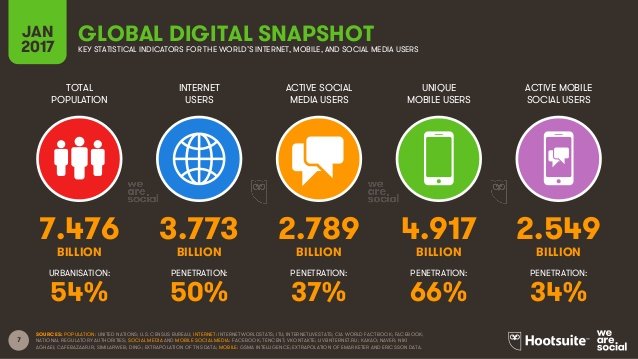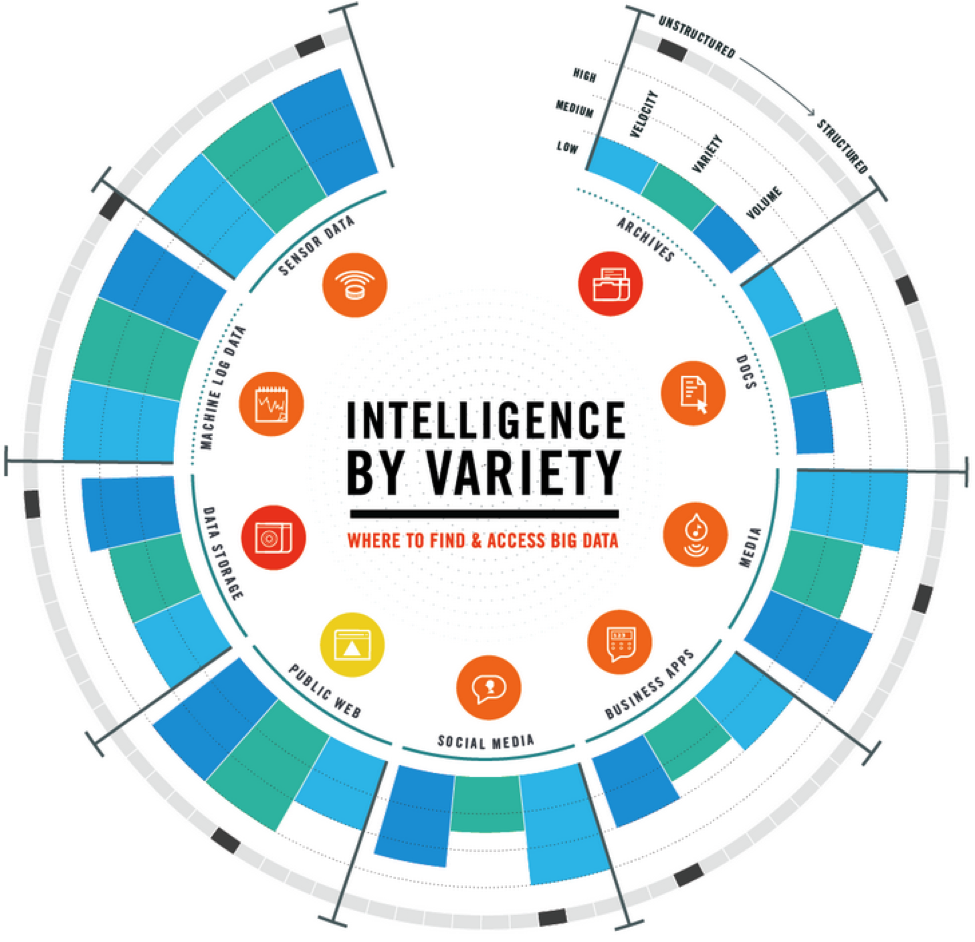
The world of social media is a decade old, and its growth has been nothing short of phenomenal. There is also no shortage of statistics to back this statement up, even now – everything from increasing internet use to smartphone penetration is boosting this growth, with no sign of stopping. Here’s a few things to crunch:
Table of Contents
Internet use continues to grow all over the world, with global users up 8% year-on-year. An increasing share of online activity takes place on mobile, with more than half of all web traffic now going to mobile phones.
The number of social media users across the globe grew by more than 20% over the past 12 months, with just below one-third of the world’s population now using social media every month. Mobile social media use is growing even faster, with global monthly active user numbers up 30% year-on-year to reach more than 2.5 billion.

Mobile connectivity continues to grow too, and the average mobile connection is getting faster as well. Nearly two-thirds of the world’s population now uses a mobile phone, and with 55% of all active connections now coming from smartphones, it’s likely that more than half of the world’s population now uses a smartphone.
One of the characteristics of the social media industry is its myriad of forms – this includes blogs, forums, business networks, photo-sharing platforms, social gaming, microblogs, chat apps, and last but not least social networks themselves.
The power of social networking is such that, the number of worldwide users is expected to reach some 2.95 billion by 2020, around a third of Earth’s entire population. An estimated 650 million of these users are expected to be from China alone and approximately a third of a million from India. The region with the highest penetration rate of social networks is North America, where around 60 percent of the population has at least one social account. As of 2016, 78 percent of the United States population had a social networking profile.
Leading social networks usually boast a high number of user accounts or strong user engagement metrics. Facebook is the only social network having surpassed the 1 billion monthly active user mark. Shortly after its launch, relative newcomer Pinterest was the fastest independent website in history to reach more than 10 million monthly unique visitors, but still lags behind other strong players, such as photo-sharing social network Instagram or microblogging platform Tumblr.
Despite the ubiquity of social networks, market potential is still increasing. This is particularly a trend in developing economies, as user engagement continues to grow in their ever increasing swaths of networking infrastructure. As of the 4th quarter of 2015, the average daily time spent on social networks by users in Brazil and Philippines was more than 3 hours, while those in the United States only clocked in at almost 1.7 hours per day.
It is reported that on an average, global internet users spend some 109 minutes per day surfing social networks. This has also birthed the social media marketing industry for engaging these virtual selves: brands and their marketers to use all this time and screen space to promote various products and services via social media marketing or social advertising.
Most of this time is also logged now via mobile devices – As of the second quarter of 2016, almost one billion Facebook users accessed the social network exclusively via mobile device, up from 655 million users in the corresponding quarter of the previous year.

While new revenue models continue to stream in, the model is increasingly based on consumer-centric, free user participation. These platforms are a ground for anyone to participate – so from the consumer side of affairs, revenue has not exactly been rosy. There are millions of bloggers – many of them don’t even boast of a revenue, let alone good revenue, nothing sustainable – while the unpredictability of trends can leave you smouldering on the road-side even as you enjoyed a stellar profit the night before.
Businesses that use social media focus on generating hits, visits, or registered users and will figure out how to monetize. Even as social networks are valued at billions of dollars, they are few and far in between – compared to the influx, or other competition, this still doesn’t stack.
Social media marketing may also not scale due to the 1:1 relationships that are needed to engage in conversations. It’s difficult for one person (despite how large their platform is) to cover all the conversations in a given market, and the excessive nature of conversations currently makes that even harder – here, Big Data, Analytics and Automation will be a big help.
The growth of this industry now needs to be performance driven – which means innovation is crucial. However, if investors keep pumping money into the sector, this simply gives rise to a complacent attitude which does not prove healthy. Companies at the top sit there precisely because others don’t have much of an incentive to cut into their share with new models backed by careful research; while the ones at the top don’t need to deviate much because they’re hemmed into their comfort zones.
Thus, with so many companies being funded without actual revenue, the market is exposed to a several variants of the same models, the same features and a sheer lack of differentiation.

There aren’t many pre-requisites when it comes to the start-up culture, and the world of tech at large due to the decentralised, outsourced nature of building your company. The social media industry is no exception – with such low entry barriers, the entrants are numerous. While it’s confusing for the consumer when it comes to choosing a service, it’s even more daunting for the provider to outshine other competitors.
If you take the example of social networking service that has been inundated crowded community platform space (aka white label social networking) industry that has over 100 vendors –all offering very similar software.

There are literally no filters for information or quality control when it comes to the social media matrix. While we respect the universal right to free speech, excess is a genuine problem for many providers and consumers alike.
While sites can give preferred content for consumers with their own personalised filters, tech literacy worldwide isn’t that acute; moreover, intrusion as concerns people’s choices can drive people away from the social network itself – with the social media marketing industry becoming highly contextual when it comes to user choices and preferences.

With the arrival of our hyper-connected world, security and privacy are becoming bigger issues with every passing day. 25% of Facebook users don’t bother with privacy settings – similar statistics exist across the board for many other websites. The highest concentration of online security threats are on mass audience sites, including social media. Online advertisements are 182 times more likely to deliver malicious content than pornography sites, for example.
According to Cisco, Facebook scams were the most common form of malware distributed in 2015; the FBI has stated that social media-related events had quadrupled over the past five years; and PWC has found that more than 1 in 8 enterprises suffered a security breach due to a social media-related cyber-attack.
Thus, the need for new protocols, regulations and security-based tech is dire, and companies simply aren’t scaling up as fast as the attackers themselves – both in terms of raising literacy, and counter-measures.
Most of the challenges social media marketers facing can be solved by the right technology vendors, but a lot of them chose the wrong partners. A survey shows that 69% of social media marketers agree that it’s more effective to buy all your social tools from the same vendor, and this is one reason they are enthralled by the promise of social suites. This stems from a lack of knowledge, combined with the black box approach created by many technological firms when it comes to providing these services.
Without a doubt, this movement of self-publishing and connecting is a disruption to the marketplace, media, the buying cycle, and the marketing funnel. Generation old barriers are crumbling from a command and control viewpoint to an open and collaborative style of business and personal communications. With these radical changes comes resistance from those who were previously in power (media, management, marketers, and governments) who are slow to adopt –and thus resist.
Despite many attempts to measure “engagement” or “ROI” there still is no industry standard to measure the efforts of social media at the personal –and corporate level. While many have developed their own ability to measure on a one-off way, there’s no industry way to quickly –and easily agree pan-industry.
Social media measurement has remained the biggest problem for social media marketers since 2003. Although there are a lot metrics, mainly engagement metrics, available for social media marketers to measure their success, not many of them are the right ones for the right programs. Senior Analysts and marketing managers will not blindly trust this data as optimizing social media programs based on the wrong metrics will lead to failure instead of success.

Technology companies pride themselves on being early adopters of the newest portals in the digital marketplace, and this openness extends to social media usage. Different departments across the organization are using social media to keep a pulse on customer, competitor, industry and community insights and trends.
Too often though, technology organizations have the tendency of keeping their social media strategies compartmentalized, isolating communication and engagement within one single function or department among many. In order to deliver key business goals in the digital era, all departments throughout an enterprise should work together to employ social media, both for internal analysis and external communication by means of a unified social media strategy.
When technology companies are able to access the social media marketplace with a unified social media strategy, they are in a better position to track ROI, increase customer satisfaction, hire better quality employees, generate more sales leads and secure brand assets.

Customer care should be on the minds of most businesses entering 2017. According to the Sprout Social Q2 2016 Index, in the first quarter of 2016, the average number of social messages needing a response grew 18% year over year. This has many brands looking for ways to increase their customer service resources and more are turning to chat-bots, and rightly so.
This also helps in managing the sheer volume of users and engaging them in some way that does not amount to ignoring them outright. Platforms like Facebook Messenger and Slack use chat-bots to communicate with customers, answer frequently-asked questions or to provide immediate information on a product or service. These chat-bots can increase communication and reduce response times to social messages in need of an answer.

Business Tools is a feature launched by Instagram to get onto the Big Data trending horse. This works in the same manner as Twitter Analytics and Facebook Insights, indicating that social media trends point toward native tool enhancements to meet business needs.
Analytics and reporting features are nothing new to the industry. A KPMG survey states that 92% of C-level executives already use data and analytics for marketing insights. And it’s very likely marketers and business owners don’t stop at measuring social media efforts as well.
In fact, a Simplify360 report found 36% of businesses use social media analytics for more than competitor analysis. The competition is only getting stronger in the social landscape, which results in more analytical thinking and marketing.
Social media is one of the world’s most significant sources for generating Big Data: 90% of available data in the world has been collected over the previous two years, and 80% of this data comes from “unstructured” sources like social media.
Social media companies not only use data on clicks, shares, posts, visits, and check-ins for their own purposes of developing hyper-targeted advertising algorithms, but also they also sell this data to third parties such as advertisers and partners, data collectors, and even investors. Twitter, for example, generated nearly 13% of their Q2 2016 revenue from licensing data and other non-advertising related sales – this is also great for the revenue model concerns that were thrown up earlier.

Optical Pattern Recognition, integration of security oriented AI, amplifications of certain extant technology – all of these are on the rise for maintaining and countering the numerous threats that exist in the social media matrix.
An effective approach requires that the business and technology sides of the company are united and fully committed to a social networking security strategy. The two must analyze content and policies in detail, as well as determine the right mix of enterprise technologies to monitor, classify, and manage data. It is essential that the business classifies data, so that employees understand precisely what is – and is not – sensitive information. This process should specifically delineate how employees may use sensitive data, as well as define who is authorized to access and share corporate content.
Strong policies and awareness programs can be reinforced with appropriate technology enforcement and monitoring solutions that protect against malware, data leakage, and other suspicious activity. Possible strategies include multi-layered security at the gateway and the end points, content classification, content filtering, data loss prevention (DLP), and mobile device management (MDM) solutions.
As can be anticipated, it is a very exciting moment for the Social industry. The sector will surely face tremendous disruption with every new technological innovation.
We consider it our duty to inform potential clients of the perils, and advantages to be found in every sector. We also consider it our privilege to work with those who are interested in augmenting their ideas with powerful technology. We are eager and only too happy to walk you through the possibilities of these measures, targeting key concerns in the sector itself, so that your business can bloom with minimal hitches.
All the technological solutions mentioned above – in the realm of big data, analytics, mobile app development, the engineering of virtual architecture and so on – can be found by working with us, in the most cogent manner possible. We will be honoured to help your venture disrupt the Social Vertical – all you need to do is take the first step, and open a dialogue with us.
